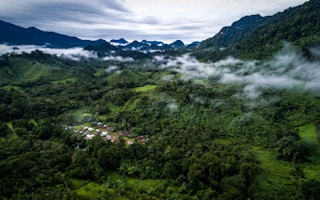Protect people against natural disasters
Another benefit that forests provide is their ability to act as a buffer against natural disasters, which have become increasingly common due to climate change.
Tree canopies can intercept rainfall and slow it down in a storm, allowing up to 30 per cent of the water to evaporate into the atmosphere without reaching the ground, according to Britain’s Woodland Trust charity.
Some cities are using urban forests to become more resilient to flooding, as trees provide more permeable land to absorb rainwater.
In Sierra Leone’s capital of Freetown, for example, after devastating landslides in 2017, the mayor’s recovery plan included training residents to plant 21,000 native trees.
Across the world’s equatorial regions, mangrove forests not only store significant carbon but provide a defence against coastal erosion and storm surges.
Defend global biodiversity
Another vital contribution of forests is their impact on biodiversity, with such ecosystems home to more than half of the world’s land-based animal and plant species.
As well as protecting nature, forests can provide a range of benefits to people, from forest foods to medicines.
Especially in tropical regions, deforestation has been linked to increased outbreaks of infectious diseases, in particularly as animals come into closer contact with people.
According to a recent analysis by the World Wildife Fund (WWF), the world’s wildflife populations have declined by more than two-thirds since 1970, with deforestation a major driver.
In the Amazon, more than 10,000 species are at risk of extinction due to the clearing of rainforest for uses such as cattle ranching and soy farming.
Provide sustainable living for communities
Deforestation leads directly to increases in local temperatures, exposing people and crops to heat stress, WRI said.
These local temperature extremes are a particular threat in the tropics for small-scale farmers, agricultural workers, indigenous people and other local communities, said Seymour of WRI.
Indigenous communities in particular rely on forests for their way of life. Research shows that they are also the best people to conserve these areas, leading to calls to put more resources in the hands of frontline communities.
In the Amazon basin, a 2021 report by the UN’s Food and Agriculture Organisation (FAO) showed that deforestation rates are up to 50 per cent lower in indigenous peoples’ forest lands than in other areas.
As world leaders look to tackle a growing climate, nature and biodiversity crisis, they should take the multiple roles of forests more seriously, the WRI report authors said.
“Forests really are part of the broader picture to keep communities healthy and safe in a changing climate,” Wolosin said.
This story was published with permission from Thomson Reuters Foundation, the charitable arm of Thomson Reuters, that covers humanitarian news, climate change, resilience, women’s rights, trafficking and property rights. Visit https://www.context.news/.










